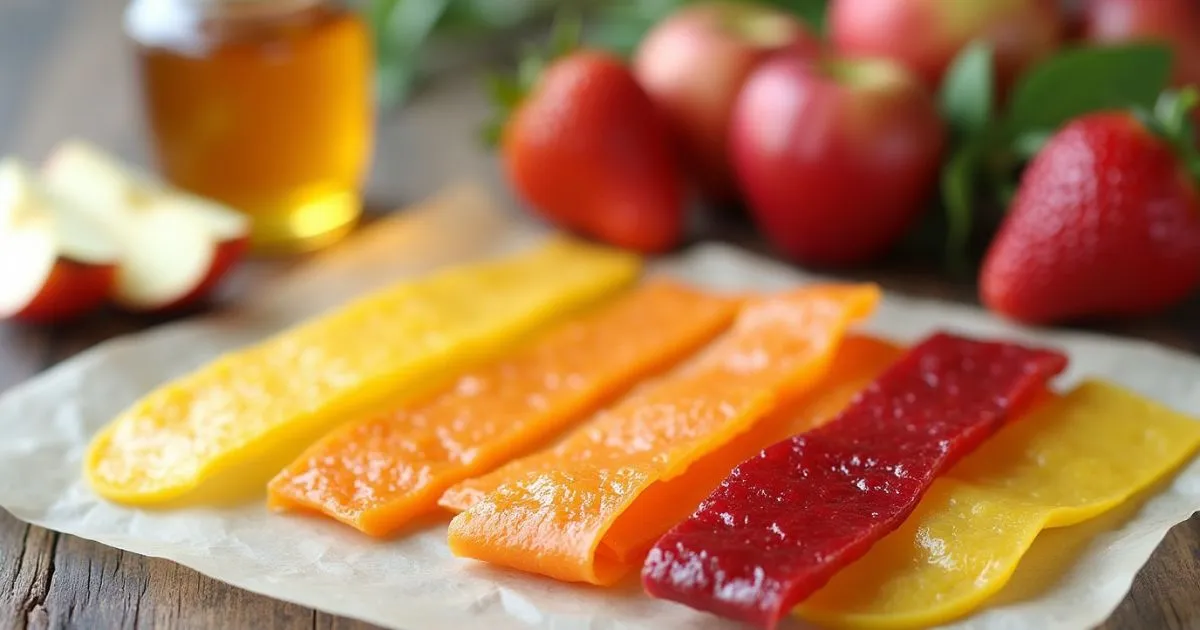Fruity and Refreshing Treats: Homemade Fruit Leather
Introduction
If you love fruity snacks but are looking for a healthier option than the sugar-filled, preservative-packed store-bought varieties, homemade fruit leather is the ideal choice. Made with 100% pure fruit and just a few simple ingredients, this homemade snack is naturally sweet, delightfully chewy, and packed with vibrant flavor. Whether you’re looking for a portable snack for on-the-go or a healthy treat to satisfy your sweet cravings, fruit leather is a fun, nutritious option that can be customized to your taste preferences.
You can make homemade fruit leather using a variety of fruits—like mangoes, apples, strawberries, or even a blend of your favorites. The best part? It’s free from any artificial additives, making it a much healthier choice than the sugary, commercial alternatives. Plus, it’s easy to prepare in large batches and store for later, making it an ideal snack for meal prep or for kids lunchboxes.
Table of Contents
Health Benefits of Homemade Fruit Leather
- Naturally Sweetened: Since whole fruit is used, the sweetness is all-natural—no added sugars or artificial sweeteners needed.
- Rich in Fiber: Made from real fruit, fruit leather offers a healthy dose of fiber that promotes digestive health and helps keep you feeling full longer.
- Full of Vitamins: Fruits like strawberries, mangoes, and apples are rich in vitamins A and C, which are important for healthy skin, immune function, and overall well-being.
- Portable and Convenient: These fruit leathers are easy to carry around and store, making them a great snack for busy days or outdoor adventures.
- Low in Calories: Homemade fruit leather offers a sweet treat that’s low in calories, without the empty calories often found in processed snacks.
Ingredients
- 3 cups of fresh fruit (e.g., strawberries, apples, mango, or a mix of your favorites)
- 1 to 2 tablespoons honey or maple syrup (optional, depending on sweetness of fruit)
- 1 tablespoon lemon juice (helps preserve color and boost flavor)
- 1/2 teaspoon vanilla extract (optional – enhances flavor)
Directions
- Prepare the Fruit: Rinse and peel the fruit if necessary (such as mangoes or apples), then chop it into small chunks. If you’re using berries, remove the stems.
- Cook the Fruit: Place the chopped fruit in a saucepan with 1/4 cup of water. Simmer over medium heat for 10–15 minutes, stirring now and then, until the fruit softens and turns into a compote-like texture.
- Blend the Fruit: Once the fruit is soft, let it cool for a few minutes. Next, transfer the mixture to a blender or food processor and blend until completely smooth. If you want a smoother texture, strain the mixture to remove seeds or pulp.
- Sweeten and Add Flavor: Taste the fruit puree. If you like a sweeter taste, you can add a little honey or maple syrup to the mix. You can also add lemon juice and vanilla extract for extra flavor and preservation.
- Spread the Puree: Line a baking sheet or dehydrator tray with parchment paper for easy removal. Evenly spread the fruit puree over the surface, approximately 1/8 inch thick. Use a spatula to spread the mixture evenly across the surface.
- Dehydrate the Mixture: If using an oven, set it to the lowest temperature, typically around 140°F (60°C). Place the baking sheet in the oven and allow the fruit puree to dehydrate for 4 to 6 hours, checking on it every hour. The fruit leather is done when it no longer feels sticky to the touch. If using a food dehydrator, follow the manufacturer’s instructions for making fruit leather, typically 4 to 6 hours at 135°F (57°C).
- Cut and Store: After the fruit leather is fully dry, peel it off the parchment paper and cut it into strips using scissors or a sharp knife. Roll the strips up and store them in an airtight container or plastic wrap. Store them in a cool, dry place for up to 2 weeks.
Creative Variations
- Mix Different Fruits: Try different fruit combinations like mango-strawberry or apple-pear for unique flavors.
- Add Spices: A dash of cinnamon, ginger, or nutmeg can infuse warmth and enhance the flavor of your fruit leather.
- Incorporate Superfoods: Add spinach, kale, or chia seeds for a nutritional boost without altering the flavor.
- Add Citrus: A splash of orange or lime juice can elevate the flavor, perfectly complementing the fruit’s natural sweetness.
Nutritional Information (Per Serving, based on 8 servings)
- Calories: 80
- Protein: 1g
- Fat: 0g
- Carbs: 21g
- Fiber: 3g
- Sugar: 18g (natural from fruit)
FAQs
1. Can I make fruit leather without added sugar? Yes! Fruit leather can be made with just fruit—if the fruit is ripe and naturally sweet, there’s no need for extra sweeteners. For a sweeter flavor, you can add a little honey or maple syrup.
2. Is it possible to use frozen fruit for making fruit leather? Yes, frozen fruit works just as effectively as fresh. Just make sure to thaw and drain any excess liquid before cooking and blending.
3. How can I tell when the fruit leather is finished? The fruit leather is done when it feels dry and isn’t sticky to the touch anymore. If it remains sticky, keep dehydrating for another hour or two.
4. Can fruit leather be stored in the freezer? Yes, fruit leather can be stored in the freezer to extend its shelf life. Make sure it’s securely wrapped in plastic wrap or stored in an airtight container.
5. How do I prevent fruit leather from sticking? To prevent sticking, always line your dehydrator trays or baking sheets with parchment paper. Dusting the surface with a thin layer of powdered sugar or cornstarch before spreading the puree can make it easier to remove.
Why This Recipe Works
Homemade Fruit Leather works as a fantastic healthy snack option because it’s made with simple, whole ingredients that are naturally sweet, rich in fiber, and full of vitamins. Unlike store-bought fruit leathers that often contain added sugars, preservatives, and artificial ingredients, this homemade version offers a cleaner, healthier alternative. The easy-to-make process allows you to control the sweetness and flavor of the leather, and with endless fruit combinations to experiment with, you can create a treat that fits your tastes and dietary needs.
Conclusion
Homemade Fruit Leather is not only a healthy, nutritious snack but also a fun DIY project that the whole family can enjoy. With minimal effort, you can make your own naturally sweet, chewy fruit leather that’s free from artificial additives. Whether you prefer it as a quick snack or an outdoor adventure companion, this homemade fruit leather is a treat that’s both wholesome and satisfying. So, grab your favorite fruits and start making this simple, delightful snack today!







